Bi-Objective Optimal Control Modification Adaptive Control for Systems with Input Uncertainty
Ⅰ. INTRODUCTION
ADAPTIVE control has been used with success in a
number of flight control applications. In certain situations,fast
adaptation is needed in order to improve tracking performance
rapidly when a system is subject to large uncertainty such as
structural damage to an aircraft that could cause rapid changes in
system dynamics. In these situations,adaptive control needs to be
able to adapt quickly by the use of large adaptive gain in order
to reduce the tracking error as fast as possible. However,fast
adaptation in adaptive control can result in high frequency
oscillations which can excite unmodeled dynamics that could
adversely affect stability of an adaptive law[1]. Poor
robustness to unmodeled dynamics,time delay,and exogenous
disturbances due to high gain adaptive control is well-known.
Thus,in general there exists a delicate balance between
performance and robustness. A large adaptive gain can generally
improve tracking performance but usually at the expense of
robustness.
To address the lack of robustness of the standard model-reference
adaptive control,the two well-known robust modification methods
in adaptive control,namely; the $\sigma$ modification[2] and
$e$ modification[3],have been used extensively in adaptive
control. Recent years have seen a surge in many new adaptive
control methods such as the $\mathcal{L}_{1}$ adaptive
control[4, 5],adaptive loop recovery[6],Kalman filter
adaptive control[7],derivative-free adaptive
control[8],command governor-based adaptive control[9],
concurrent learning adaptive control[10],least-squares
model-reference adaptive control[11],composite
model-reference adaptive control[12],and optimal control
modification[13, 14]; just to name a few. In terms of
addressing fast adaptation,the $\mathcal{L}_{1}$ adaptive control
has gained a considerable attention due to its ability to achieve
robustness with fast adaptation for a given a priori bound on the
uncertainty. The existence of theoretical bounds on the transient
performance and time delay margin of the $\mathcal{L}_{1}$
adaptive control enables it to address one of the current
challenges in verification and validation: the lack of
theoretically justifiable metrics[15]. One of the key
features of the $\mathcal{L}_{1}$ adaptive control is the
existence of a linear input-output mapping with fast adaptation
which helps to address the problem with predictability of
nonlinear control[4, 5].
The optimal control modification has been developed using an
optimal control framework to minimize the $\mathcal{L}_{2}$ norm
of the tracking error bounded away from the origin by some lower
bound[13]. By increasing the lower bound,robustness can be
improved by trading off with tracking performance. A number of
extensions have been developed for the optimal control
modification method. In the presence of actuator rate limiting,a
time-scale separation principle is applied to the method to
decouple the slow-fast system via the singular
perturbation[16]. This approach improves tracking
performance in the presence of slow actuator dynamics. The optimal
control modification method has also been used in conjunction with
the newly developed derivative-free adaptive control[17].
In terms of applications and validation,the optimal control
modification method has been demonstrated in many flight
environments ranging from low-fidelity desktop simulations to
high-fidelity piloted motion-based flight simulations and flight
testing on a piloted aircraft. For desktop simulations,the optimal
control modification method has been applied to various aircraft
models including NASA generic transport model (GTM) with damaged
flight dynamics[13] and aeroelastic longitudinal
dynamics[18],a general aviation aircraft[19],and a NASA
F/A-18A aircraft model[20]. In 2009,a piloted flight
simulation study has been conducted in a motion-based flight
simulator at NASA Ames Research Center participated by eight NASA
test pilots. Favorable Cooper-Harper ratings by the NASA test pilots
have been noted with the optimal control modification adaptive
law[21, 22]. Subsequently,a series of flight experiments were
conducted in late 2010 and early 2011 onboard a NASA F/A-18A test
aircraft at NASA Dryden Flight Research Center to evaluate the
effectiveness of the optimal control modification method with
normalization[23]. The flight test results show that the
optimal control modification method offers the potential for flight
control performance improvements under certain degraded flight
control characteristics[24, 25].
In certain situations,the control effectiveness of a control
system may be impaired due to failures. When an uncertainty exists
in the control input,the system can undergo significant changes
in its closed-loop characteristics that can compromise stability
and performance of the control system. The control signal must be
modified accordingly to produce achievable dynamics in the
presence of the reduced control effectiveness. A new approach
based on the optimal control modification adaptive law has been
developed to address this issue. A parallel predictor model is
constructed to relate the predictor error to the estimation error
of the control effectiveness matrix. In this work,we will develop
an optimal control modification adaptive control approach that
seeks to minimize a bi-objective linear quadratic cost function of
both the tracking error norm and the predictor error norm
simultaneously. The resulting adaptive laws for the parametric
uncertainty and control effectiveness uncertainty are dependent on
both the tracking error and the predictor error,while the
adaptive laws for the feedback gain and command feedforward gain
are only dependent on the tracking error. In this context,the new
adaptive law may be somewhat similar to the composite
model-reference adaptive control[12],but there also exists a
significant difference in that the optimal control modification
term that provides robustness to adaptive control does not exist
in composite model-reference adaptive control and is derived from
the optimal control formulation.
Ⅱ. BI-OBJECTIVE OPTIMAL CONTROL MODIFICATION ADAPTIVE LAWS
Consider the following nonlinear plant with control input
uncertainty,matched uncertainty,and unmatched disturbance
|
\begin{align}
\dot{x}=Ax+B\Lambda\left[u+\Theta^{*{\rm
T}}\Phi\left(x\right)\right]+w,\label{1}
\end{align}
|
(1)
|
where $x\left(t\right)\in{\bf R}^{n}$ is a state vector,
$u\left(t\right)\in{\bf R}^{m}$ is a control vector,$A\in{\bf
R}^{n\times n}$ is known,$B\in{\bf R}^{n\times m}$ is also known
such that $\left(A,B\right)$ is controllable,
$\Lambda=\Lambda^{\rm T}>0\in{\bf R}^{m\times m}$ is a constant
unknown diagonal matrix with diagonal elements that represents a
control input uncertainty,$\Theta^{*}\in{\bf R}^{p\times m}$ is a
constant and unknown matrix that represents a matched parametric
uncertainty,$\Phi\left(x\right)\in{\bf R}^{p}$ is a vector of
known bounded regressors,and $w\left(t\right)\in{\bf R}^{n}$ is
an unmatched bounded disturbance with bounded time derivative,
i.e.,$\sup_{\forall t}\left\Vert w\right\Vert \le w_{0}$ and
$\sup_{\forall t}\left \Vert \dot{w}\right\Vert \le\delta_{0}$.
A nominal fixed-gain controller is designed to stabilize the
nominal plant which does not have uncertainty,i.e.,$\Lambda=I$
and $\Theta^{*}=0$,and to enable it to track a reference command
signal $r\left(t\right)$ as follows:
|
\begin{align}
\bar{u}=\bar{K}_{x}x+\bar{K}_{r}r,
\end{align}
|
(2)
|
where $r\left(t\right)\in{\bf R}^{r}$ is a bounded reference
command signal,such that $A+B\bar{K}_{x}\in{\bf R}^{n\times n}$
is Hurwitz,and $B\bar{K}_{r}\in{\bf R}^{n\times r}$.
The closed-loop nominal plant without uncertainty is then used to
specify a reference model
|
\begin{align}
\dot{x}_{m}=A_{m}x_{m}+B_{m}r,
\end{align}
|
(3)
|
where $x_{m}\left(t\right)\in{\bf R}^{n}$ is a reference state
vector,$A_{m}=A+B\bar{K}_{x}$,and $B_{m}=B\bar{K}_{r}$.
In the presence of both the control input uncertainty and matched
uncertainty due to $\Lambda$ and $\Theta^{*}$,an adaptive
controller is designed as
|
\begin{align}
u=K_{x}\left(t\right)x+K_{r}\left(t\right)r-\Theta^{\rm
T}\left(t\right)\Phi\left(x\right),\label{eq:-349}
\end{align}
|
(4)
|
where $K_{x}\left(t\right)\in{\bf R}^{m\times n}$ is an adaptive
feedback gain,$K_{r}\left(t\right)\in{\bf R}^{m\times r}$ is an
adaptive command feedforward gain,and
$\Theta\left(t\right)\in{\bf R}^{p\times m}$ is the estimate of
$\Theta^{*}$.
We assume that there exist constant and unknown matrices
$K_{x}^{*}$ and $K_{r}^{*}$ such that the following matching
conditions are satisfied
|
\begin{align}
&\Lambda K_{x}^{*}=\bar{K}_{x},\label{eq:-349-1}
\end{align}
|
(5)
|
|
\begin{align}
&\Lambda K_{r}^{*}=\bar{K}_{r}.
\end{align}
|
(6)
|
If $\Lambda$ is unknown but sign of $\Lambda$ is known,then the
standard model-reference adaptive control (MRAC) laws are given by
|
\begin{align}
&\dot{K}_{x}^{\rm T}=\Gamma_{x}xe^{\rm T}PB\textrm{sgn}\Lambda,
\end{align}
|
(7)
|
|
\begin{align}
&\dot{K}_{r}^{\rm T}=\Gamma_{r}re^{\rm T}PB\textrm{sgn}\Lambda,
\end{align}
|
(8)
|
|
\begin{align}
&\dot{\Theta}=-\Gamma_{\Theta}\Phi\left(x\right)e^{\rm
T}PB\textrm{sgn}\Lambda.
\end{align}
|
(9)
|
It is well-known that the standard MRAC is non-robust. To improve
robustness,the adaptive laws should include a robustness
modification scheme or use the projection method. If $\Lambda$ is
completely unknown,then we need to consider other approaches. We
now introduce an optimal control modification method that uses two
types of errors for adaptation: tracking error and predictor
error. We call this bi-objective optimal control modification
adaptive control.
Let
$\tilde{\Lambda}\left(t\right)=\hat{\Lambda}\left(t\right)-\Lambda$,
$\tilde{K}_{x}\left(t\right)=K_{x}\left(t\right)-K_{x}^{*}$,
$\tilde{K}_{r}\left(t\right)=K_{r}\left(t\right)-K_{r}^{*}$,and
$\tilde{\Theta}\left(t\right)=\Theta\left(t\right)-\Theta^{*}$ be
the estimation errors. Then the closed-loop plant becomes
|
\begin{align}
&\dot{x}=A_{m}x+B_{m}r+B\left(\hat{\Lambda}-\tilde{\Lambda}\right)\times\notag\\
&\qquad \left[\tilde{K}_{x}x+\tilde{K}_{r}r-\tilde{\Theta}^{\rm
T}\Phi\left(x\right)\right]+w.
\end{align}
|
(10)
|
We define the tracking error as
$e\left(t\right)=x_{m}\left(t\right)-x\left(t\right)$,then the
tracking error equation is obtained as
|
\begin{align}
&\dot{e}=\dot{x}_{m}-\dot{x}=A_{m}e+B\hat{\Lambda}\times\notag\\
&\qquad \left[-\tilde{K}_{x}x-\tilde{K}_{r}r+\tilde{\Theta}^{\rm
T}\Phi\left(x\right)\right]-w+B\epsilon,
\end{align}
|
(11)
|
where $\epsilon\left(x,r\right)\in{\bf R}^{m}$ is the residual
estimation error of the plant model
|
\begin{align}
\epsilon=\tilde{\Lambda}\left[\tilde{K}_{x}x+\tilde{K}_{r}r-
\tilde{\Theta}^{\rm T}\Phi\left(x\right)\right],
\end{align}
|
(12)
|
such that $\sup_{\forall x,r}\left\Vert \epsilon\right\Vert
\le\epsilon_{0}$.
Consider a predictor model of the plant as
|
\begin{align}
\dot{\hat{x}}=A_{m}\hat{x}+\left(A-A_{m}\right)x+B\hat{\Lambda}
\left[u+\Theta^{\rm T}\Phi\left(x\right)\right]+\hat{w},
\end{align}
|
(13)
|
where $\hat{w}\left(t\right)$ is the estimate of the disturbance
$w\left(t\right)$.
We define the predictor error as
$e_{p}\left(t\right)=\hat{x}\left(t\right)-x\left(t\right)$,then
the predictor error equation is obtained as
|
\begin{align}
&\dot{e}_{p}=A_{m}e_{p}+B\tilde{\Lambda}\left[u+\Theta^{\rm T}\Phi\left(x\right)\right]+\notag\\
&\qquad B\hat{\Lambda}\tilde{\Theta}^{\rm
T}\Phi\left(x\right)+\tilde{w}+B\epsilon_{p},\label{DUPLICATE:
eq:predictor}
\end{align}
|
(14)
|
where
$\tilde{w}\left(t\right)=\hat{w}\left(t\right)-w\left(t\right)$ is
the disturbance estimation error,and
$\epsilon_{p}\left(x\right)\in{\bf R}^{m}$ is the residual
estimation error of the predictor model
|
\begin{align}
\epsilon_{p}=-\tilde{\Lambda}\tilde{\Theta}^{\rm
T}\Phi\left(x\right),
\end{align}
|
(15)
|
such that $\sup_{\forall x}\left\Vert \epsilon_{p}\right\Vert
\le\epsilon_{p_{0}}$.
Proposition. The nonlinear plant with control input
uncertainty,matched uncertainty,and unmatched disturbance can be
controlled using the following bi-objective optimal control
modification adaptive laws:
|
\begin{align}
&\dot{K}_{x}^{\rm T}=\Gamma_{x}x\left(e^{\rm T}P+\nu u^{\rm T}\hat
{\Lambda}^{\rm T}B^{\rm T}PA_{m}^{-1}\right)B\hat{\Lambda},
\end{align}
|
(16)
|
|
\begin{align}
&\dot{K}_{r}^{\rm T}=\Gamma_{r}r\left(e^{\rm T}P+\nu
u^{\rm T}\hat{\Lambda}^{\rm T}B^{\rm T}PA_{m}^{-1}\right)B\hat{\Lambda},
\end{align}
|
(17)
|
|
\begin{align}
&\dot{\Theta}=-\Gamma_{\Theta}\Phi\left(x\right)\biggl(e^{\rm T}P+\nu u^{\rm T}
\hat{\Lambda}^{\rm T}B^{\rm T}PA_{m}^{-1}+e_{p}^{\rm T}W-\notag\\
&\qquad \eta\left\{ \left[u+2\Theta^{\rm
T}\Phi\left(x\right)\right]^{\rm T}\hat{\Lambda}^{\rm T}B^{\rm
T}+\hat{w}^{\rm T}\right\}
WA_{m}^{-1}\biggr)B\hat{\Lambda},\label{eq:-26-2-1-2}
\end{align}
|
(18)
|
|
\begin{align}
&\dot{\hat{\Lambda}}^{\rm T}=-\Gamma_{\Lambda}\biggl(\left[u+\Theta^{\rm T}
\Phi\left(x\right)\right]e_{p}^{\rm T}W-\notag\\
&\qquad \eta\left\{ \left[u+2\Theta^{\rm
T}\Phi\left(x\right)\right]^{\rm T}\hat{\Lambda}^{\rm T}B^{\rm
T}+\hat{w}^{\rm T}\right\}
WA_{m}^{-1}\biggr)B,
\end{align}
|
(19)
|
|
\begin{align}
&\dot{\hat{w}}^{\rm T}=-\gamma_{w}\biggl(e_{p}^{\rm T}W-\notag\\
&\qquad \eta\left\{ \left[u+2\Theta^{\rm
T}\Phi\left(x\right)\right]^{\rm T}\hat{\Lambda}^{\rm T}B^{\rm
T}+\hat{w}^{\rm T}\right\} WA_{m}^{-1}\biggr),\label{eq:-363-3}
\end{align}
|
(20)
|
where
$\Gamma_{x}=\Gamma_{x}^{\rm T}>0\in{\bf R}^{n\times n}$,
$\Gamma_{r}=\Gamma_{r}^{\rm T}>0\in{\bf R}^{r\times r}$,
$\Gamma_{\Theta}=\Gamma_{\Theta}^{\rm T}>0\in{\bf R}^{p\times p}$,
$\Gamma_{\Lambda}=\Gamma_{\Lambda}^{\rm T}>0\in{\bf R}^{m\times
m}$,and $\gamma_{w}>0\in{\bf R}$ are positive-definite adaptive
gain matrices; $\nu>0\in{\bf R}$ and $\eta>0\in{\bf R}$ are the
optimal control modification parameters; and $P=P^{\rm T}>0\in{\bf
R}^{n\times n}$ and $W=W^{\rm T}>0\in{\bf R}^{n\times n}$ are
solutions to the following Lyapunov equations:
|
\begin{align}
&PA_{m}+A_{m}^{\rm T}P=-Q,
\end{align}
|
(21)
|
|
\begin{align}
&WA_{m}+A_{m}^{\rm T}W=-R,
\end{align}
|
(22)
|
where $Q=Q^{\rm T}>0\in{\bf R}^{n\times n}$ and $R=R^{\rm
T}>0\in{\bf R}^{n\times n}$ are positive-definite weighting
matrices.
We note that $K_{x}\left(t\right)$ and $K_{r}\left(t\right)$ are
adapted based on the tracking error,$\hat{\Lambda}\left(t\right)$
and $\hat{w}\left(t\right)$ are adapted based on the predictor
error,and $\Theta\left(t\right)$ is adapted based on both the
tracking error and predictor error.
The adaptive control architecture with the bi-objective optimal
control modification is presented in Fig. 1.
Proof. The optimal control modification adaptive laws (16)
and (17) are called bi-objective because they use both the tracking
error and the predictor error for adaptation and are derived from
the following infinite-time horizon cost functions:
|
\begin{align}
&J_{1}=\lim_{t_{f}\rightarrow\infty}\frac{1}{2}\int_{0}^{t_{f}}
\left(e-\Delta_{1}\right)^{\rm T}Q\left(e-\Delta_{1}\right){\rm
d}t,
\end{align}
|
(23)
|
|
\begin{align}
&J_{2}=\lim_{t_{f}\rightarrow\infty}\frac{1}{2}\int_{0}^{t_{f}}
\left(e_{p}-\Delta_{2}\right)^{\rm
T}R\left(e_{p}-\Delta_{2}\right){\rm d}t
\end{align}
|
(24)
|
subject to (11) and (14),where $\Delta_{1}$ and
$\Delta_{2}$ represent the unknown lower bounds of the tracking
error and the predictor error,respectively.
The cost functions $J_{1}$ and $J_{2}$ are combined into the
following bi-objective cost function:
|
\begin{align}
J=J_{1}+J_{2}.
\end{align}
|
(25)
|
The bi-objective cost function $J$ combines both the objectives of
minimization of the tracking error and the predictor error bounded
away from the origin. Geometrically,it represents a distance
measured from a point on the trajectory of $e\left(t\right)$ and
$e_{p}\left(t\right)$ to the normal surface of a hypersphere
$B_{\Delta}=\left\{ e\left(t\right)\in {\bf
R}^{n},e_{p}\left(t\right)\in{\bf
R}^{n}:\frac{1}{2}\left(e-\Delta_{1}\right)^{\rm T}Q
\left(e-\Delta_{1}\right)+\right.\left.\frac{1}{2}\left(e_{p}-\Delta_{2}\right)^{\rm
T}R\left(e_{p}-\Delta_{2}\right) \le\Delta^{2}\right\}
\subset\mathcal{D}\subset{\bf R}^{n}$ where $\Delta$ is the largest
norm of the cost function $J$. The bi-objective cost function is
designed to provide robustness by not seeking asymptotic tracking,
but rather bounded tracking. By not requiring asymptotic tracking,
the adaptation can be made more robust. Therefore,in effect,this
framework provides a trade-off between performance and robustness by
a suitable selection of the modification parameters $\nu$ and $\eta$
which influence the lower bounds $\Delta_{1}$ and $\Delta_{2}$.
Better performance can be obtained by choosing small values of $\nu$
and/or $\eta$,but this decreases robustness of the adaptive laws to
unmodeled dynamics,and vice versa.
The derivation of the bi-objective optimal control modification
adaptive laws (16) $\sim$ (20) is established by the
Pontryagin$'$s minimum principle. Using the optimal control
framework,the Hamiltonian of the cost function is defined as
|
\begin{align}
&H\!=\!\frac{1}{2}\left(e-\Delta_{1}\right)^{\rm
T}Q\left(e-\Delta_{1}\right)+
\frac{1}{2}\left(e_{p}-\Delta_{2}\right)^{\rm T}R\left(e_{p}\!-\!\Delta_{2}\right)\!+\!\notag\\
&\quad\lambda^{\rm T}\left\{
A_{m}e+B\hat{\Lambda}\left[-\tilde{K}_{x}x-
\tilde{K}_{r}r+\tilde{\Theta}^{\rm T}\Phi\left(x\right)\right]-w+B\epsilon\right\} \!+\!\notag\\
&\quad \mu^{\rm T}\Bigl\{
A_{m}e_{p}+B\tilde{\Lambda}\left[u+\Theta^{\rm
T}\Phi\left(x\right)\right]
+B\hat{\Lambda}\tilde{\Theta}^{\rm T}\Phi\left(x\right)+\notag\\
&\quad \tilde{w}+B\epsilon_{p}\Bigr\},\label{eq:-3-1}
\end{align}
|
(26)
|
where $\lambda\left(t\right):\left[0,\infty\right)\rightarrow{\bf
R}^{n}$ and
$\mu\left(t\right):\left[0,\infty\right)\rightarrow{\bf R}^{n}$
are the adjoint variables or co-state vectors of $e\left(t\right)$
and $e_{p}\left(t\right)$,respectively.
The adjoint equations can be obtained from the necessary
conditions of optimality as follows:
|
\begin{align}
&\dot{\lambda}=-\nabla
H_{e}^{\rm T}=-Q\left(e-\Delta_{1}\right)-A_{m}^{\rm T}\lambda,\label{eq:-4-1}
\end{align}
|
(27)
|
|
\begin{align}
&\dot{\mu}=-\nabla H_{e_{p}}^{\rm
T}=-R\left(e_{p}-\Delta_{2}\right)-A_{m}^{\rm
T}\mu,
\end{align}
|
(28)
|
subject to the transversality conditions
$\lambda\left(t_{f}\rightarrow\infty\right)=0$ and
$\mu\left(t_{f}\rightarrow\infty\right)=0$ since both
$e\left(0\right)$ and $e_{p}\left(0\right)$ are assumed to be
known.
Treating $\tilde{K}_{x}\left(t\right)$,
$\tilde{K}_{r}\left(t\right)$,$\tilde{\Theta}\left(t\right)$,
$\tilde{\Lambda}\left(t\right)$,and $\hat{w}\left(t\right)$ as
control variables,then the optimal control solutions are obtained
by the following gradient-based adaptive laws:
|
\begin{align}
&\dot{K}_{x}^{\rm T}=\dot{\tilde{K}}_{x}^{\rm T}=-\Gamma_{x}\nabla
H_{\tilde{K}_{x}}=\Gamma_{x}x\lambda^{\rm T}B\hat{\Lambda},\label{eq:-6-1}
\end{align}
|
(29)
|
|
\begin{align}
&\dot{K}_{r}^{\rm T}=\dot{\tilde{K}}_{r}^{\rm T}=-\Gamma_{r}\nabla
H_{\tilde{K}_{r}}=\Gamma_{r}r\lambda^{\rm T}B\hat{\Lambda},\label{eq:-7-1}
\end{align}
|
(30)
|
|
\begin{align}
&\dot{\Theta}=\dot{\tilde{\Theta}}=-\Gamma_{\Theta}\nabla
H_{\tilde{\Theta}}^{\rm T}=-\Gamma_{\Theta}\Phi\left(x\right)\left(\lambda^{\rm T}+\mu^{\rm T}\right)B\hat{\Lambda},\label{eq:-5-1}
\end{align}
|
(31)
|
|
\begin{align}
&\dot{\hat{\Lambda}}^{\rm T}=\dot{\tilde{\Lambda}}^{\rm
T}=-\Gamma_{\Lambda}\nabla
H_{\tilde{\Lambda}}=-\Gamma_{\Lambda}\left[u+\Theta^{\rm T}\Phi\left(x\right)\right]\mu^{\rm T}B,\label{eq:-19-1}
\end{align}
|
(32)
|
|
\begin{align}
&\dot{\hat{w}}^{\rm T}=-\gamma_{w}\nabla
H_{\hat{w}}=-\gamma_{w}\mu^{\rm T}.\label{eq:-348}
\end{align}
|
(33)
|
The closed-form solutions can be obtained by eliminating the
adjoint variables $\lambda\left(t\right)$ and $\mu\left(t\right)$
using the "sweep" method[26] with the following assumed
solutions of the adjoint equations
|
\begin{align}
&\lambda=Pe+S\left[-K_{x}x-K_{r}r+\Theta^{\rm T}\Phi\left(x\right)\right],\label{eq:-8-1}
\end{align}
|
(34)
|
|
\begin{align}
&\mu=We_{p}+T\left[u+2\Theta^{\rm
T}\Phi\left(x\right)\right]+V.\label{eq:-9-1}
\end{align}
|
(35)
|
Substituting the adjoint solutions back into the adjoint equations
yields
|
\begin{align}
&\dot{P}e+PA_{m}e+PB\hat{\Lambda}\left[-K_{x}x-K_{r}r+\Theta^{\rm T}\Phi\left(x\right)\right]-\notag\\
&\qquad PB\hat{\Lambda}\left[-K_{x}^{*}x-K_{r}^{*}r+\Theta^{*{\rm T}}\Phi\left(x\right)\right]-Pw+PB\epsilon+\notag\\
&\qquad \dot{S}\left[-K_{x}x-K_{r}r+\Theta^{\rm T}\Phi\left(x\right)\right]+\notag\\
&\qquad S\frac{d\left[-K_{x}x-K_{r}r+\Theta^{\rm T}\Phi\left(x\right)\right]}{dt}=-Q\left(e-\Delta_{1}\right)-\notag\\
&\qquad A_{m}^{\rm T}Pe-A_{m}^{\rm T}S\left[-K_{x}x-K_{r}r+\Theta^{\rm T}\Phi\left(x\right)\right],\label{eq:-10-1}
\end{align}
|
(36)
|
|
\begin{align}
&\dot{W}e_{p}+WA_{m}e_{p}+WB\hat{\Lambda}\left[u+\Theta^{\rm T}\Phi\left(x\right)\right]-WB\Lambda\times\notag\\
&\qquad \left[u+\Theta^{\rm T}\Phi\left(x\right)\right]+WB\hat{\Lambda}\Theta^{\rm T}\Phi\left(x\right)-WB\hat{\Lambda}\Theta^{*{\rm T}}\Phi\left(x\right)+\notag\\
&\qquad W\hat{w}-Ww+WB\epsilon_{p}+\dot{T}\left[u+2\Theta^{\rm T}\Phi\left(x\right)\right]+\notag\\
&\qquad T\frac{{\rm d}\left[u+2\Theta^{\rm T}\Phi\left(x\right)\right]}{{\rm d}t}+\dot{V}=-R\left(e_{p}-\Delta_{2}\right)-\notag\\
&\qquad A_{m}^{\rm T}We_{p}-A_{m}^{\rm T}T\left[u+2\Theta^{\rm
T}\Phi\left(x\right)\right]-A_{m}^{\rm T}V.\label{eq:-11-1}
\end{align}
|
(37)
|
Equating terms yields the following equations:
|
\begin{align}
&\dot{P}+PA_{m}+A_{m}^{\rm T}P+Q=0,\label{eq:-12-1}
\end{align}
|
(38)
|
|
\begin{align}
&\dot{S}+A_{m}^{\rm T}S+PB\hat{\Lambda}=0,\label{eq:-13-2}
\end{align}
|
(39)
|
|
\begin{align}
&Q\Delta_{1}+PB\hat{\Lambda}\left[-K_{x}^{*}x-K_{r}^{*}r+\Theta^{*{\rm T}}\Phi\left(x\right)\right]+Pw-\notag\\
&\qquad
PB\epsilon-S\frac{{\rm d}\left[-K_{x}x-K_{r}r+\Theta^{\rm T}\Phi\left(x\right)\right]}{{\rm d}t}=0\label{eq:-23-1}
\end{align}
|
(40)
|
|
\begin{align}
&\dot{W}+WA_{m}+A_{m}^{\rm T}W+R=0\label{eq:-14-1}
\end{align}
|
(41)
|
|
\begin{align}
&\dot{T}+A_{m}^{\rm T}T+WB\hat{\Lambda}=0\label{eq:-15-1}
\end{align}
|
(42)
|
|
\begin{align}
&\dot{V}+A_{m}^{\rm T}V+W\hat{w}=0\label{eq:-364}
\end{align}
|
(43)
|
|
\begin{align}
&R\Delta_{2}+WB\Lambda\left[u+\Theta^{\rm T}\Phi\left(x\right)\right]+WB\hat{\Lambda}\Theta^{*{\rm T}}\Phi\left(x\right)+Ww-\notag\\
&\qquad WB\epsilon_{p}-T\frac{{\rm d}\left[u+2\Theta^{\rm
T}\Phi\left(x\right)\right]}{{\rm d}t}=0,
\end{align}
|
(44)
|
subject to the transversality conditions
$P\left(t_{f}\rightarrow\infty\right)=0$,
$S\left(t_{f}\rightarrow\infty\right)=0$,
$W\left(t_{f}\rightarrow\infty\right)=0$,and
$T\left(t_{f}\rightarrow\infty\right)=0$.
The existence and uniqueness of the solution of the Lyapunov
differential equations are well-established[27]. The
infinite-time horizon solutions of the Lyapunov differential
equations tend to their equilibrium solutions at $t=0$ as
$\dot{P}\left(t\right)\rightarrow0$ and
$\dot{W}\left(t\right)\rightarrow0$. Thus
|
\begin{align}
&PA_{m}+A_{m}^{\rm T}P+Q=0,\label{eq:-12-1-1}
\end{align}
|
(45)
|
|
\begin{align}
&WA_{m}+A_{m}^{\rm T}W+R=0.\label{eq:-14-1-1}
\end{align}
|
(46)
|
The solutions of $S\left(t\right)$,$T\left(t\right)$,and
$V\left(t\right)$ also tend to their equilibrium solutions
|
\begin{align}
&A_{m}^{\rm T}S+PB\hat{\Lambda}=0,\label{eq:-13-2-1}
\end{align}
|
(47)
|
|
\begin{align}
&A_{m}^{\rm T}T+WB\hat{\Lambda}=0,\label{eq:-15-1-1}
\end{align}
|
(48)
|
|
\begin{align}
&A_{m}^{\rm T}V+W\hat{w}=0.\label{eq:-364-1}
\end{align}
|
(49)
|
As with any control design,performance and robustness are often
considered as the two competing design requirements. Increasing
robustness tends to require a compromise in performance and vice
versa. Thus,to enable the bi-objective optimal control
modification adaptive laws to be sufficiently flexible for control
design,the modification parameters $\nu>0$ and $\eta>0$ are
introduced as free design parameters to allow for adjustments of
the bi-objective optimal control modification terms in the
adaptive laws.
Thus,the solutions of $S\left(t\right)$,$T\left(t\right)$,and
$V\left(t\right)$ are modified as
|
\begin{align}
&S=-\nu A_{m}^{-{\rm T}}PB\hat{\Lambda},\label{eq:-24-1}
\end{align}
|
(50)
|
|
\begin{align}
&T=-\eta A_{m}^{-{\rm T}}WB\hat{\Lambda},
\end{align}
|
(51)
|
|
\begin{align}
&V=-\eta A_{m}^{-{\rm T}}W\hat{w}.\label{eq:-365}
\end{align}
|
(52)
|
Using the expression of $u\left(t\right)$,the adjoint solutions
are then obtained as
|
\begin{align}
&\lambda=Pe+\nu A_{m}^{-{\rm T}}PB\hat{\Lambda}u,\label{eq:-25-1}
\end{align}
|
(53)
|
|
\begin{align}
&\mu=We_{p}-\eta A_{m}^{-{\rm T}}W\left\{
B\hat{\Lambda}\left[u+2\Theta^{\rm
T}\Phi\left(x\right)\right]+\hat{w}\right\}.
\end{align}
|
(54)
|
Substituting the adjoint solutions into the gradient-based
adaptive laws yields the bi-objective optimal control modification
adaptive laws (16) $\sim$ (20).
The bounds on $\Delta_{1}\left(t\right)$ and
$\Delta_{2}\left(t\right)$ as $t_{f}\rightarrow\infty$ are then
given by
|
\begin{align}
&\left\Vert \Delta_{1}\right\Vert \le\frac{1}{\lambda_{\rm min}\left(Q\right)}\Biggl
[\left\Vert PB\hat{\Lambda}\right\Vert \left\Vert -K_{x}^{*}x-\Delta K_{r}^{*}r+
\Theta^{*{\rm T}}\Phi\left(x\right)\right\Vert+ \notag\\
&\qquad \lambda_{\rm max}\left(P\right)w_{0}+\left\Vert PB\right\Vert \epsilon_{0}+\notag\\
&\qquad \nu\left\Vert A_{m}^{-{\rm T}}PB\hat{\Lambda}\right\Vert
\left\Vert \frac{{\rm d}\left[-K_{x}x-K_{r}r+\Theta^{\rm
T}\Phi\left(x\right)\right]}{{\rm d}t}\right\Vert
\Biggr],
\end{align}
|
(55)
|
|
\begin{align}
&\left\Vert \Delta_{2}\right\Vert \le\frac{1}{\lambda_{\rm min}\left(R\right)}\Biggl
[\left\Vert WB\Lambda\right\Vert \left\Vert u+\Theta^{\rm T}\Phi\left(x\right)\right\Vert +\notag\\
&\qquad \left\Vert WB\hat{\Lambda}\right\Vert \left\Vert \Theta^{*{\rm T}}\Phi\left(x\right)
\right\Vert +\lambda_{\rm max}\left(W\right)w_{0}+\left\Vert WB\right\Vert \epsilon_{p_{0}}+\notag\\
&\qquad \eta\left\Vert A_{m}^{-{\rm T}}WB\hat{\Lambda}\right\Vert
\left\Vert \frac{{\rm d}\left[u+\Theta^{\rm
T}\Phi\left(x\right)\right]}{{\rm d}t}\right\Vert \Biggr],
\end{align}
|
(56)
|
which are dependent upon the modification parameters,control
effectiveness uncertainty,matched uncertainty,unmatched
disturbance,and residual tracking error and predictor error.
Note that if $R=Q$ and $\eta=\nu$,then the bi-objective optimal
control modification adaptive laws for $\Theta\left(t\right)$,
$\hat{\Lambda}\left(t\right)$,and $\hat{w}\left(t\right)$ become
|
\begin{align}
\dot{\Theta}=-\Gamma_{\Theta}\Phi\left(x\right)\left(e^{\rm T}P+e_{p}^{\rm T}P\right.-\\
\left.\nu\left\{ 2\Phi^{\rm T}\left(x\right)\Theta\hat{\Lambda}^{\rm
T}B^{\rm T}+\hat{w}^{\rm T}\right\}
PA_{m}^{-1}\right)B\hat{\Lambda},\label{eq:-20-1}
\end{align}
|
(57)
|
|
\begin{align}
\dot{\hat{\Lambda}}^{\rm T}=-\Gamma_{\Lambda}\left[u+\Theta^{\rm T}\Phi\left(x\right)\right]\left(e_{p}^{\rm T}P\right.-\\
\left.\nu\left\{ \left[u+2\Theta^{\rm
T}\Phi\left(x\right)\right]^{\rm T}\hat{\Lambda}^{\rm T}B^{\rm
T}+\hat{w}^{\rm T}\right\} PA_{m}^{-1}\right)B,\label{eq:-20-1-1}
\end{align}
|
(58)
|
|
\begin{align}
\dot{\hat{w}}^{\rm T}=-\gamma_{w}\left(e_{p}^{\rm T}P\right.-\\
\left.\nu\left\{ \left[u+2\Theta^{\rm
T}\Phi\left(x\right)\right]^{\rm T}\hat{\Lambda}^{\rm T}B^{\rm
T}+\hat{w}^{\rm T}\right\} PA_{m}^{-1}\right).\label{eq:-363-2}
\end{align}
|
(59)
|
Theorem. The bi-objective optimal control
modification adaptive laws (16) $\sim$ (20) result in stable and
uniformly ultimately bounded tracking error $e\left(t\right)$ and
bounded predictor error $e_{p}\left(t\right)$.
Proof. Choose a Lyapunov candidate function
|
\begin{align}
&V=e^{\rm T}Pe+e_{p}^{\rm T}We_{p}+\textrm{trace}\left(\tilde{K}_{x}\Gamma_{x}^{-1}\tilde{K}_{x}^{\rm T}\right)+\notag\\
&\qquad \textrm{trace}\left(\tilde{K}_{r}\Gamma_{r}^{-1}\tilde{K}_{r}^{\rm T}\right)+\textrm{trace}\left(\tilde{\Theta}^{\rm T}\Gamma_{\Theta}^{-1}\tilde{\Theta}\right)+\notag\\
&\qquad
\textrm{trace}\left(\tilde{\Lambda}\Gamma_{\Lambda}^{-1}\tilde{\Lambda}^{\rm
T}\right)+\tilde{w}^{\rm
T}\gamma_{w}^{-1}\tilde{w}.\label{DUPLICATE: eq:-349}
\end{align}
|
(60)
|
Evaluating
$\dot{V}\left(e,e_{p},\tilde{K}_{x},\tilde{K}_{r},\tilde{\Theta},\tilde{\Lambda},\tilde{w}\right)$
yields
|
\begin{align}
&\dot{V}=-e^{\rm T}Qe+2e^{\rm T}PB\hat{\Lambda}\left[-\tilde{K}_{x}x-\tilde{K}_{r}r+\tilde{\Theta}^{\rm T}\Phi\left(x\right)\right]-\notag\\
&\qquad 2e^{\rm T}Pw+2e^{\rm T}PB\epsilon-e_{p}^{\rm T}Re_{p}+\notag\\
&\qquad 2e_{p}^{\rm T}WB\left\{ \tilde{\Lambda}\left[u+\Theta^{\rm T}\Phi\left(x\right)\right]+\hat{\Lambda}\tilde{\Theta}^{\rm T}\Phi\left(x\right)\right\}+\notag \\
&\qquad 2e_{p}^{\rm T}WB\epsilon_{p}-2\dot{w}^{\rm T}\gamma_{w}^{-1}\tilde{w}+\notag\\
&\qquad 2\textrm{trace}\left(\tilde{K}_{x}x\left(e^{\rm T}P+\nu u^{\rm T}\hat{\Lambda}^{\rm T}B^{\rm T}PA_{m}^{-1}\right)B\hat{\Lambda}\right)+\notag\\
&\qquad 2\textrm{trace}\left(\tilde{K}_{r}r\left(e^{\rm T}P+\nu u^{\rm T}\hat{\Lambda}^{\rm T}B^{\rm T}PA_{m}^{-1}\right)B\hat{\Lambda}\right)-\notag\\
&\qquad 2\textrm{trace}\Biggl(\tilde{\Theta}^{\rm T}\Phi\left(x\right)\biggl(e^{\rm T}P+\nu u^{\rm T}\hat{\Lambda}^{\rm T}B^{\rm T}PA_{m}^{-1}+e_{p}^{\rm T}W-\notag\\
&\qquad \eta\left\{ \left[u+2\Theta^{\rm T}\Phi\left(x\right)\right]^{\rm T}\hat{\Lambda}^{\rm T}B^{\rm T}+\hat{w}^{\rm T}\right\} WA_{m}^{-1}\biggr)B\hat{\Lambda}\Biggr)-\notag\\
&\qquad 2\textrm{trace}\Biggl(\tilde{\Lambda}\left[u+\Theta^{\rm T}\Phi\left(x\right)\right]\biggl(e_{p}^{\rm T}W-\notag\\
&\qquad \eta\left\{ \left[u+2\Theta^{\rm T}\Phi\left(x\right)\right]^{\rm T}\hat{\Lambda}^{\rm T}B^{\rm T}+\hat{w}^{\rm T}\right\} WA_{m}^{-1}\biggr)B\Biggr)+\notag\\
&\qquad 2\left(\eta\left\{ \left[u+2\Theta^{\rm
T}\Phi\left(x\right)\right]^{\rm T}\hat{\Lambda}^{\rm T}B^{\rm
T}+\hat{w}^{\rm T}\right\} WA_{m}^{-1}\right)\tilde{w}.
\end{align}
|
(61)
|
Using the trace identity $\textrm{trace}\left(C^{\rm
T}D\right)=DC^{\rm T}$ where $C$ and $D$ are any arbitrary vectors
of the same dimension,
$\dot{V}\left(e,e_{p},\tilde{K}_{x},\tilde{K}_{r},\tilde{\Theta},\tilde{\Lambda},\tilde{w}\right)$
can be further simplified as
|
\begin{align}
&\dot{V}=-e^{\rm T}Qe-2e^{\rm T}Pw+2e^{\rm T}PB\epsilon-e_{p}^{\rm T}Re_{p}+2e_{p}^{\rm T}WB\epsilon_{p}-\notag\\
&\qquad 2\dot{w}^{\rm T}\gamma_{w}^{-1}\tilde{w}+2\nu u^{\rm T}\hat{\Lambda}^{\rm T}B^{\rm T}PA_{m}^{-1}B\hat{\Lambda}\tilde{u}+\notag\\
&\qquad 2\eta\textrm{trace}\biggl(\tilde{\Theta}^{\rm T}\Phi\left(x\right)\times\notag\\
&\qquad \left\{ \left[u+2\Theta^{\rm T}\Phi\left(x\right)\right]^{\rm T}\hat{\Lambda}^{\rm T}B^{\rm T}+\hat{w}^{\rm T}\right\} WA_{m}^{-1}B\hat{\Lambda}\biggr)+\notag\\
&\qquad 2\eta\textrm{trace}\biggl(\tilde{\Lambda}\left[u+\Theta^{\rm T}\Phi\left(x\right)\right]\times\notag\\
&\qquad \left\{ \left[u+2\Theta^{\rm T}\Phi\left(x\right)\right]^{\rm T}\hat{\Lambda}^{\rm T}B^{\rm T}+\hat{w}^{\rm T}\right\} WA_{m}^{-1}B\biggr)+\notag\\
&\qquad 2\eta\textrm{trace}\biggl(\tilde{w}\times\notag\\
&\qquad \left\{ \left[u+2\Theta^{\rm
T}\Phi\left(x\right)\right]^{\rm T}\hat{\Lambda}^{\rm T}B^{\rm
T}+\hat{w}^{\rm T}\right\} WA_{m}^{-1}\biggr),
\end{align}
|
(62)
|
where $\tilde{u}=\tilde{K}_{x}x+\tilde{K}_{r}r-\tilde{\Theta}^{\rm
T}\Phi\left(x\right)$.
Let $\bar{B}=\left[\begin{array}{ccc} B\hat{\Lambda} & B &
I\end{array}\right]\in{\bf R}^{n\times\left(2m+n\right)}$,
$\Omega=\left[\begin{array}{ccc}
\Theta & 0 & 0\\
0 & \hat{\Lambda}^{\rm T} & 0\\
0 & 0 & \hat{w}^{\rm T}
\end{array}\right]\in{\bf R}^{\left(p+m+1\right)\times\left(2m+n\right)}$,
$\Psi\left(x,r\right)=\left[\begin{array}{c}
\Phi\left(x\right)\\
u+\Theta^{\rm T}\Phi\left(x\right)\\
1
\end{array}\right]\in{\bf R}^{p+m+1}$. Then
|
\begin{align}
&\textrm{trace}\left(\tilde{\Omega}^{\rm T}\Psi\left(x,r\right)\Psi^{\rm T}\left(x,r\right)\Omega\bar{B}^{\rm T}WA_{m}^{-1}\bar{B}\right)=\notag\\
&\textrm{trace}\biggl(\tilde{\Theta}^{\rm T}\Phi\left(x\right)\times\notag\\
&\qquad \left\{ \left[u+2\Theta^{\rm T}\Phi\left(x\right)\right]^{\rm T}\hat{\Lambda}^{\rm T}B^{\rm T}+\hat{w}^{\rm T}\right\} WA_{m}^{-1}B\hat{\Lambda}\biggr)+\notag\\
&\qquad \textrm{trace}\biggl(\tilde{\Lambda}\left[u+\Theta^{\rm T}\Phi\left(x\right)\right]\times\notag\\
&\qquad \left\{ \left[u+2\Theta^{\rm T}\Phi\left(x\right)\right]^{\rm T}\hat{\Lambda}^{\rm T}B^{\rm T}+\hat{w}^{\rm T}\right\} WA_{m}^{-1}B\biggr)+\notag\\
&\qquad \textrm{trace}\biggl(\tilde{w}\times\notag\\
&\qquad \left\{ \left[u+2\Theta^{\rm
T}\Phi\left(x\right)\right]^{\rm T}\hat{\Lambda}^{\rm T}B^{\rm
T}+\hat{w}^{\rm T}\right\} WA_{m}^{-1}\biggr),
\end{align}
|
(63)
|
where $\tilde{\Omega}=\Omega-\Omega^{*}$ and
$\Omega^{*}=\left[\begin{array}{ccc}
\Theta^{*} & 0 & 0\\
0 & \Lambda^{\rm T} & 0\\
0 & 0 & w^{\rm T}
\end{array}\right]\in{\bf R}^{\left(p+m+1\right)\times\left(2m+n\right)}$.
Thus,
|
\begin{align}
&\dot{V}=-e^{\rm T}Qe-2e^{\rm T}Pw+2e^{\rm T}PB\epsilon-e_{p}^{\rm T}Re_{p}+2e_{p}^{\rm T}WB\epsilon_{p}-\notag\\
&\qquad2\dot{w}^{\rm T}\gamma_{w}^{-1}\tilde{w}+2\nu u^{\rm T}\hat{\Lambda}^{\rm T}B^{\rm T}PA_{m}^{-1}B\hat{\Lambda}\tilde{u}+\notag\\
&\qquad2\eta\Psi^{\rm T}\left(x,r\right)\Omega\bar{B}^{\rm
T}WA_{m}^{-1}\bar{B}\tilde{\Omega}^{\rm T}\Psi\left(x,r\right).
\end{align}
|
(64)
|
Note that $B^{\rm T}PA_{m}^{-1}B^{\rm T}$ and $\bar{B}^{\rm
T}WA_{m}^{-1}\bar{B}$ are both negative-definite matrices,
therefore
|
\begin{align}
&\dot{V}=-e^{\rm T}Qe-2e^{\rm T}Pw+2e^{\rm T}PB\epsilon-e_{p}^{\rm T}Re_{p}+2e_{p}^{\rm T}WB\epsilon_{p}-\notag\\
&\qquad 2\dot{w}^{\rm T}\gamma_{w}^{-1}\tilde{w}-\nu\tilde{u}^{\rm T}\hat{\Lambda}^{\rm T}B^{\rm T}A_{m}^{-{\rm T}}QA_{m}^{-1}B\hat{\Lambda}\tilde{u}-\notag\\
&\qquad \eta\Psi^{\rm T}\left(x,r\right)\tilde{\Omega}\bar{B}^{\rm T}A_{m}^{-{\rm T}}RA_{m}^{-1}\bar{B}\tilde{\Omega}^{\rm T}\Psi\left(x,r\right)+\notag\\
&\qquad 2\nu u^{*{\rm T}}\hat{\Lambda}^{\rm T}B^{\rm T}PA_{m}^{-1}B\hat{\Lambda}\tilde{u}+\notag\\
&\qquad 2\eta\Psi^{\rm T}\left(x,r\right)\Omega^{*}\bar{B}^{\rm
T}WA_{m}^{-1}\bar{B}\tilde{\Omega}^{\rm T}\Psi\left(x,r\right).
\end{align}
|
(65)
|
Let $K=\left[\begin{array}{ccc} K_{x} & K_{r} & -\Theta^{\rm
T}\end{array}\right]\in{\bf R}^{m\times\left(n+r+p\right)}$,and
$z\left(x,r\right)=\left[\begin{array}{c}
x\\
r\\
\Phi\left(x\right)
\end{array}\right]\in{\bf R}^{n+r+p}$. Then $u=Kz\left(x,r\right)$ and
|
\begin{align}
&\dot{V}\le-\lambda_{\rm min}\left(Q\right)\left\Vert e\right\Vert ^{2}+2\left\Vert e\right\Vert \lambda_{\rm max}
\left(P\right)w_{0}+2\left\Vert e\right\Vert \left\Vert PB\right\Vert \epsilon_{0}-\notag\\
&\qquad \lambda_{\rm min}\left(R\right)\left\Vert e_{p}\right\Vert
^{2}+2\left\Vert e_{p}\right\Vert \left\Vert
WB\right\Vert \epsilon_{p_{0}}+2\gamma_{w}^{-1}\left\Vert \tilde{\Omega}\right\Vert \delta_{0}-\notag\\
&\qquad \nu\lambda_{\rm min}\left(B^{\rm T}A_{m}^{-{\rm
T}}QA_{m}^{-1}B\right)\left\Vert z\left(x,r\right)\right\Vert ^{2}
\left\Vert \hat{\Lambda}\right\Vert ^{2}\left\Vert \tilde{K}\right\Vert ^{2}+\notag\\
&\qquad 2\nu\left\Vert z\left(x,r\right)\right\Vert ^{2}\left\Vert B^{\rm T}PA_{m}^{-1}B\right\Vert
\left\Vert \hat{\Lambda}\right\Vert ^{2}\left\Vert \tilde{K}\right\Vert K_{0}-\notag\\
&\qquad \eta\lambda_{\rm min}\left(A_{m}^{-{\rm
T}}RA_{m}^{-1}\right)\left\Vert \Psi\left(x,r\right)
\right\Vert ^{2}\left\Vert \bar{B}\right\Vert ^{2}\left\Vert \tilde{\Omega}\right\Vert ^{2}+\notag\\
&\qquad 2\eta\left\Vert WA_{m}^{-1}\right\Vert \left\Vert
\Psi\left(x,r\right)\right\Vert ^{2}\left\Vert \bar{B}\right\Vert
^{2}\left\Vert \tilde{\Omega}\right\Vert \Omega_{0}
\end{align}
|
(66)
|
where $K_{0}=\left\Vert K^{*}\right\Vert $ and
$\Omega_{0}=\left\Vert \Omega^{*}\right\Vert $.
Let
$c_{1}=\lambda_{\rm min}\left(Q\right)$,$c_{2}=\frac{\lambda_{\rm
max}\left(P\right)w_{0}+\left\Vert PB\right\Vert
\epsilon_{0}}{\lambda_{\rm min}\left(Q\right)}$,$c_{3}=\lambda_{\rm
min}\left(R\right)$, $c_{4}=\frac{\left\Vert WB\right\Vert
\epsilon_{p_{0}}}{\lambda_{\rm min}\left(R\right)}$,
$c_{5}=\lambda_{\rm min}\left(B^{\rm T}A_{m}^{-{\rm
T}}QA_{m}^{-1}B\right)\left\Vert z\left(x,r\right)\right\Vert ^{2}$,
$c_{6}=\frac{\left\Vert B^{\rm T}PA_{m}^{-1}B\right\Vert
K_{0}}{\lambda_{\rm min}\left(B^{\rm T}A_{m}^{-{\rm
T}}QA_{m}^{-1}B\right)}$, $c_{7}=\lambda_{\rm
min}\left(A_{m}^{-{\rm T}}RA_{m}^{-1}\right)\left\Vert
\Psi\left(x,r\right)\right\Vert ^{2}$, and $c_{8}=\frac{\left\Vert
WA_{m}^{-1}\right\Vert \Omega_{0}}{\lambda_{\rm
min}\left(A_{m}^{-{\rm
T}}RA_{m}^{-1}\right)}+\frac{\gamma_{w}^{-1}\delta_{0}}{\eta
c_{7}\left\Vert \bar{B}\right\Vert ^{2}}$. Then
|
\begin{align}
&\dot{V}\le-c_{1}\left(\left\Vert e\right\Vert -c_{2}\right)^{2}+c_{1}c_{2}^{2}-c_{3}\left(\left\Vert e_{p}\right\Vert -c_{4}\right)^{2}+c_{3}c_{4}^{2}-\notag\\
&\qquad \nu c_{5}\left\Vert \hat{\Lambda}\right\Vert ^{2}\left(\left\Vert \tilde{K}\right\Vert -c_{6}\right)^{2}+\nu c_{5}c_{6}^{2}\left\Vert \hat{\Lambda}\right\Vert ^{2}-\notag\\
&\qquad \eta c_{7}\left\Vert \bar{B}\right\Vert ^{2}\left(\left\Vert
\tilde{\Omega}\right\Vert -c_{8}\right)^{2}+\eta
c_{7}c_{8}^{2}\left\Vert \bar{B}\right\Vert ^{2}.
\end{align}
|
(67)
|
Note that
|
\begin{align}
\left\Vert \hat{\Lambda}\right\Vert \le\left\Vert \Omega\right\Vert
\Rightarrow\left\Vert \tilde{\Lambda}\right\Vert \le\left\Vert
\tilde{\Omega}\right\Vert,\label{eq:-2}
\end{align}
|
(68)
|
|
\begin{align}
&\left\Vert \hat{\Lambda}\right\Vert ^{2}=\left\Vert \Lambda+\tilde{\Lambda}\right\Vert ^{2}\le\left\Vert \Lambda\right\Vert ^{2}+2\left\Vert \Lambda\right\Vert \left\Vert \tilde{\Lambda}\right\Vert +\left\Vert \tilde{\Lambda}\right\Vert ^{2}\le\notag\\
&\qquad \left\Vert \Lambda\right\Vert ^{2}+2\left\Vert
\Lambda\right\Vert \left\Vert \tilde{\Omega}\right\Vert
+\left\Vert \tilde{\Omega}\right\Vert ^{2},
\end{align}
|
(69)
|
|
\begin{align}
&\left\Vert \bar{B}\right\Vert ^{2}=\left\Vert \bar{B}^{*}+\tilde{B}\right\Vert ^{2}\le\left\Vert \bar{B}^{*}\right\Vert ^{2}+2\left\Vert \bar{B}^{*}\right\Vert \left\Vert \tilde{B}\right\Vert +\left\Vert \tilde{B}\right\Vert ^{2}\le\notag\\
&\qquad \left\Vert \bar{B}^{*}\right\Vert ^{2}+2\left\Vert \bar{B}^{*}\right\Vert \left\Vert B\right\Vert \left\Vert \tilde{\Lambda}\right\Vert +\left\Vert B\right\Vert ^{2}\left\Vert \tilde{\Lambda}\right\Vert ^{2}\le\notag\\
&\qquad\left\Vert \bar{B}^{*}\right\Vert ^{2}+2\left\Vert
\bar{B}^{*}\right\Vert \left\Vert B\right\Vert \left\Vert
\tilde{\Omega}\right\Vert +\left\Vert B\right\Vert ^{2}\left\Vert
\tilde{\Omega}\right\Vert ^{2},
\end{align}
|
(70)
|
where
$\tilde{B}=\bar{B}-\bar{B}^{*}$ and
$\bar{B}^{*}=\left[\begin{array}{ccc} B\Lambda & B &
I\end{array}\right]\in{\bf R}^{n\times\left(2m+n\right)}$.
Note that $\dot{V}\left(e,e_{p},\tilde{K},\tilde{\Omega}\right)$
can be upper-bounded by maximizing the terms in (66) that depend
on $\left\Vert \hat{\Lambda}\right\Vert $ and $\left\Vert
\bar{B}\right\Vert $ which in turn depend on $\left\Vert
\tilde{K}\right\Vert $ and $\left\Vert \tilde{\Omega}\right\Vert
$. Thus,taking the partial derivatives with respect to
$\left\Vert \tilde{K}\right\Vert $ and $\left\Vert
\tilde{\Omega}\right\Vert $ and setting them to zero yield
$\left\Vert \tilde{K}\right\Vert =c_{6}$,and
|
\begin{align}
&2\nu c_{5}c_{6}^{2}\left(\left\Vert \Lambda\right\Vert +\left\Vert \tilde{\Omega}\right\Vert \right)-2\eta c_{7}\left\Vert \bar{B}\right\Vert ^{2}\left(\left\Vert \tilde{\Omega}\right\Vert -c_{8}\right)-\notag\\
&\qquad2\eta c_{7}\left\Vert B\right\Vert \left\Vert \tilde{\Omega}\right\Vert \left(\left\Vert \bar{B}^{*}\right\Vert +\left\Vert B\right\Vert \left\Vert \tilde{\Omega}\right\Vert \right)\left(\left\Vert \tilde{\Omega}\right\Vert -2c_{8}\right)=\notag\\
&\qquad 0,\label{eq:-8}
\end{align}
|
(71)
|
whose solution yields one of the roots $\left\Vert
\tilde{\Omega}\right\Vert =c_{9}$ that maximizes these terms.
Consider two limiting cases:
1) When $\left\Vert \tilde{\Omega}\right\Vert \ll1$ and
$\left\Vert \tilde{\Omega}\right\Vert \ll\left\Vert
\Lambda\right\Vert $,then $\left\Vert \hat{\Lambda}\right\Vert
^{2}\le\left(1+\epsilon_{1}\right)^{2}\left\Vert
\Lambda\right\Vert ^{2}$ and $\left\Vert \bar{B}\right\Vert
^{2}\le\left(1+\epsilon_{2}\right)^{2}\left\Vert
\bar{B}^{*}\right\Vert ^{2}$ where $\epsilon_{1}=\frac{\left\Vert
\tilde{\Omega}\right\Vert }{\left\Vert \Lambda\right\Vert }>0$ and
$\epsilon_{2}=\frac{\left\Vert B\right\Vert \left\Vert
\tilde{\Omega}\right\Vert }{\left\Vert \bar{B}^{*}\right\Vert }>0$
are small positive constants. Setting the partial derivative with
respect to $\left\Vert \tilde{\Omega}\right\Vert $ to zero yields
|
\begin{align}
-2\eta c_{7}\left(1+\epsilon_{2}\right)^{2}\left\Vert
\bar{B}^{*}\right\Vert ^{2}\left(\left\Vert
\tilde{\Omega}\right\Vert -c_{8}\right)=0\label{eq:-11}
\end{align}
|
(72)
|
whose solution is $\left\Vert \tilde{\Omega}\right\Vert
=c_{9}=c_{8}$ which maximizes the terms that depend on $\left\Vert
\tilde{\Omega}\right\Vert $ since the second partial derivative
with respect to $\left\Vert \tilde{\Omega}\right\Vert $ is always
negative.
2) When $\left\Vert \tilde{\Omega}\right\Vert \gg1$ and
$\left\Vert \tilde{\Omega}\right\Vert \gg\left\Vert
\Lambda\right\Vert $,then $\left\Vert \hat{\Lambda}\right\Vert
^{2}\le\left(1+\epsilon_{3}\right)^{2}\left\Vert
\tilde{\Omega}\right\Vert ^{2}$ and $\left\Vert \bar{B}\right\Vert
^{2}\le\left(1+\epsilon_{4}\right)^{2}\left\Vert B\right\Vert
^{2}\left\Vert \tilde{\Omega}\right\Vert ^{2}$ where
$\epsilon_{3}=\frac{\left\Vert \Lambda\right\Vert }{\left\Vert
\tilde{\Omega}\right\Vert }>0$ and $\epsilon_{4}=\frac{\left\Vert
\bar{B}^{*}\right\Vert }{\left\Vert B\right\Vert \left\Vert
\tilde{\Omega}\right\Vert }>0$ are small positive constants.
Evaluating the partial derivative with respect to $\left\Vert
\tilde{\Omega}\right\Vert $ gives
|
\begin{align}
&2\nu c_{5}c_{6}^{2}\left(1+\epsilon_{3}\right)^{2}\left\Vert \tilde{\Omega}\right\Vert -4\eta c_{7}\left(1+\epsilon_{4}\right)^{2}\left\Vert B\right\Vert ^{2}\left\Vert \tilde{\Omega}\right\Vert ^{3}+\notag\\
&\qquad 6\eta c_{7}\left(1+\epsilon_{4}\right)^{2}\left\Vert
B\right\Vert ^{2}\left\Vert \tilde{\Omega}\right\Vert ^{2}c_{8}=0,
\end{align}
|
(73)
|
Equation (73) yields only one positive root $\left\Vert
\tilde{\Omega}\right\Vert
=c_{9}=\frac{3c_{8}}{4}\left(1+\sqrt{1+\frac{8\nu
c_{5}c_{6}^{2}\left(1+\epsilon_{3}\right)^{2}}{9\eta
c_{7}c_{8}^{2}\left(1+\epsilon_{4}\right)^{2}\left\Vert
B\right\Vert ^{2}}}\right)$. Evaluating the second partial
derivative with respect to $\left\Vert \tilde{\Omega}\right\Vert $
at this root gives a negative value of $-4\nu
c_{5}c_{6}^{2}\left(1+\epsilon_{3}\right)^{2}-6\eta
c_{7}c_{8}c_{9}\left(1+\epsilon_{4}\right)^{2}\left\Vert
B\right\Vert ^{2}$. This shows that $\left\Vert
\tilde{\Omega}\right\Vert =c_{9}$ maximizes the terms that depend
on $\left\Vert \tilde{\Omega}\right\Vert $.
Therefore,this results in $\left\Vert \hat{\Lambda}\right\Vert
^{2}\le\Lambda_{0}^{2}:=\left\Vert \Lambda\right\Vert
^{2}+2\left\Vert \Lambda\right\Vert c_{9}+c_{9}^{2}$ and
$\left\Vert \bar{B}\right\Vert ^{2}\le B_{0}^{2}:=\left\Vert
\bar{B}^{*}\right\Vert ^{2}+2\left\Vert \bar{B}^{*}\right\Vert
\left\Vert B\right\Vert c_{9}+\left\Vert B\right\Vert
^{2}c_{9}^{2}$. Thus,
$\dot{V}\left(e,e_{p},\tilde{K},\tilde{\Omega}\right)\le0$ outside
a compact set $\mathcal{S}$ defined as
|
\begin{align}
&\mathcal{S}=\Biggl\{\left(e\left(t\right),e_{p}\left(t\right),\tilde{K}\left(t\right),\tilde{\Omega}\left(t\right)\right):c_{1}\left(\left\Vert e\right\Vert -c_{2}\right)^{2}+\notag\\
&\qquad c_{3}\left(\left\Vert e_{p}\right\Vert -c_{4}\right)^{2}+\nu c_{5}\Lambda_{0}^{2}\left(\left\Vert \tilde{K}\right\Vert -c_{6}\right)^{2}+\notag\\
&\qquad \eta c_{7}B_{0}^{2}\left(\left\Vert \tilde{\Omega}\right\Vert -c_{8}\right)^{2}\le c_{1}c_{2}^{2}+c_{3}c_{4}^{2}+\notag\\
&\qquad \nu c_{5}c_{6}^{2}\Lambda_{0}^{2}+\eta
c_{7}c_{8}^{2}B_{0}^{2}\Biggr\}.
\end{align}
|
(74)
|
This implies
|
\begin{align}
&\left\Vert e\right\Vert \ge
c_{2}+\sqrt{c_{2}^{2}+\frac{c_{3}c_{4}^{2}+\nu
c_{5}c_{6}^{2}\Lambda_{0}^{2}+\eta
c_{7}c_{8}^{2}B_{0}^{2}}{c_{1}}}=r,
\end{align}
|
(75)
|
|
\begin{align}
&\left\Vert e_{p}\right\Vert \ge
c_{4}+\sqrt{c_{4}^{2}+\frac{c_{1}c_{2}^{2}+\nu
c_{5}c_{6}^{2}\Lambda_{0}^{2}+\eta
c_{7}c_{8}^{2}B_{0}^{2}}{c_{3}}}=p,
\end{align}
|
(76)
|
|
\begin{align}
&\left\Vert \tilde{K}\right\Vert \ge
c_{6}+\sqrt{c_{6}^{2}+\frac{c_{1}c_{2}^{2}+c_{3}c_{4}^{2}+\eta
c_{7}c_{8}^{2}B_{0}^{2}}{\nu c_{5}\Lambda_{0}^{2}}}=\alpha,
\end{align}
|
(77)
|
|
\begin{align}
\left\Vert \tilde{\Omega}\right\Vert \ge
c_{8}+\sqrt{c_{8}^{2}+\frac{c_{1}c_{2}^{2}+c_{3}c_{4}^{2}+\nu
c_{5}c_{6}^{2}\Lambda_{0}^{2}}{\eta
c_{7}B_{0}^{2}}}=\beta,\label{eq:-362}
\end{align}
|
(78)
|
There exist $z_{0}$ and $\Psi_{0}$ such that $\left\Vert
z\left(x,r\right)\right\Vert \le z_{0}$ and $\left\Vert
\Psi\left(x,r\right)\right\Vert \le\Psi_{0}$ for any
$0 < \nu < \nu_{\rm max}$ and $0 < \eta < \eta_{\rm max}$ that satisfy the
following inequalities:
|
\begin{align}
&\varphi\left(\left\Vert x\right\Vert ,\left\Vert x_{m}\right\Vert ,Q,
\nu,w_{0},\epsilon_{0},\Lambda_{0},K_{0}\right)=-c_{1}\left\Vert x\right\Vert ^{2}+\notag\\
&\qquad 2\left(c_{1}c_{2}+\lambda_{\rm max}\left(Q\right)\left\Vert
x_{m}\right\Vert \right)\left\Vert x\right\Vert
+2c_{1}c_{2}\left\Vert x_{m}\right\Vert-
\notag\\
&\qquad c_{1}\left\Vert
x_{m}\right\Vert ^{2}+c_{3}c_{4}^{2}+\nu c_{5}\left(\left\Vert z\left(x,r\right)\right\Vert \right)c_{6}^{2}\Lambda_{0}^{2}+\notag\\
&\qquad \eta c_{7}\left(\left\Vert \Psi\left(x,r\right)\right\Vert
\right)c_{8}^{2}B_{0}^{2}\le0,\label{eq:-196-3}
\end{align}
|
(79)
|
|
\begin{align}
&\phi\left(\left\Vert x_{p}\right\Vert ,\left\Vert x_{m}\right\Vert ,R,\eta,\dot{w}_{0},
\epsilon_{p_{0}},B_{0},\Omega_{0}\right)=-c_{3}\left\Vert x_{p}\right\Vert ^{2}+\notag\\
&\qquad 2\left(c_{3}c_{4}+\lambda_{\rm
max}\left(R\right)\left\Vert x\right\Vert \right)
\left\Vert x_{p}\right\Vert +2c_{3}c_{4}\left\Vert x\right\Vert -c_{3}\left\Vert x\right\Vert ^{2}+\notag\\
&\qquad c_{1}c_{2}^{2}+\nu c_{5}\left(\left\Vert z\left(x,r\right)\right\Vert \right)c_{6}^{2}\Lambda_{0}^{2}+\notag\\
&\qquad \eta c_{7}\left(\left\Vert \Psi\left(x,r\right)\right\Vert
\right)c_{8}^{2}B_{0}^{2}\le0.\label{eq:-196-3-1}
\end{align}
|
(80)
|
Then,the lower bounds which are dependent on $\left\Vert
z\left(x,r\right)\right\Vert $ and $\left\Vert
\Psi\left(x,r\right)\right\Vert $ also exist. Since
$\dot{V}\left(e,e_{p},\tilde{K},\tilde{\Omega}\right)\le0$ outside
the compact set $\mathcal{S}$,
$\lim_{t\rightarrow\infty}V\left(e,e_{p},\tilde{K},\tilde{\Omega}\right)\le
V_{0}$,where $V_{0}$ is the largest lower bound of
$V\left(e,e_{p},\tilde{K},\tilde{\Omega}\right)$ which is given by
|
\begin{align}
&V_{0}=\lambda_{\rm max}\left(P\right)r^{2}+\lambda_{\rm max}\left(W\right)p^{2}+\lambda_{\rm max}
\left(\Gamma_{x}^{-1}\right)\alpha^{2}+\notag\\
&\qquad \lambda_{\rm max}\left(\Gamma_{r}^{-1}\right)\alpha^{2}+\lambda_{\rm max}\left(\Gamma_{\Theta}^{-1}\right)
\left(\alpha^{2}+\beta^{2}\right)+\notag\\
&\qquad \lambda_{\rm
max}\left(\Gamma_{\Lambda}^{-1}\right)\beta^{2}+\gamma_{w}^{-1}\beta^{2}.\label{eq:-16}
\end{align}
|
(81)
|
Then
|
\begin{align}
&\lambda_{\rm
min}\left(P\right)\lim_{t\rightarrow\infty}\left\Vert e\right\Vert
^{2}\le\lim_{t\rightarrow\infty}V\left(e,e_{p},\tilde{K},\tilde{\Omega}\right)\le
V_{0},\label{eq:-9}
\end{align}
|
(82)
|
|
\begin{align}
&\lambda_{\rm
min}\left(W\right)\lim_{t\rightarrow\infty}\left\Vert
e_{p}\right\Vert
^{2}\le\lim_{t\rightarrow\infty}V\left(e,e_{p},\tilde{K},\tilde{\Omega}\right)\le
V_{0}.\label{eq:-10}
\end{align}
|
(83)
|
Therefore,the closed-loop system is uniformly ultimately bounded
with the following ultimate bounds as $t\rightarrow\infty$:
|
\begin{align}
&\left\Vert e\right\Vert
\le\sqrt{\frac{V_{0}}{\lambda_{\rm min}\left(P\right)}},\label{eq:-191-2-2}
\end{align}
|
(84)
|
|
\begin{align}
&\left\Vert e_{p}\right\Vert \le\sqrt{\frac{V_{0}}{\lambda_{\rm
min}\left(W\right)}}.
\end{align}
|
(85)
|
Example. Consider a first-order SISO plant
\begin{align*}
\dot{x}=ax+b\lambda\left[u\left(t-t_{d}\right)+\theta^{*}x^{2}\right]+w,
\end{align*} where $a=-1$ and $b=1$ are known,$\lambda$ and
$\theta^{*}$ are unknown but it is assumed that $\lambda=-1$ and
$\theta^{*}=0.1$ for simulations,$t_{d}=0.2$ s is a known time
delay,and $w\left(t\right)=0.01\left(\sin t+\cos2t\right)$.
The reference model is given by
\begin{align*}
\dot{x}_{m}=a_{m}x_{m}+b_{m}r,
\end{align*} where $a_{m}=-2$,
$b_{m}=2$,and $r\left(t\right)=\sin t$.
The nominal control input effectiveness is equal to unity,i.e.,
$\lambda^{*}=1$. So,$\lambda=-1$ represents a full control
reversal.
The adaptive controller is designed as
\begin{align*}
u=k_{x}\left(t\right)x+k_{r}r\left(t\right)-\theta\left(t\right)x^{2},
\end{align*} where $k_{x}\left(t\right)$,$k_{r}\left(t\right)$,
and $\theta\left(t\right)$ are computed by the following
bi-objective optimal control modification adaptive laws:
\begin{align*}
&\dot{k}_{x}=\gamma_{x}x\left(e+\nu
a_{m}^{-1}ub\hat{\lambda}\right)b\hat{\lambda},\\
&\dot{k}_{r}=\gamma_{r}r\left(e+\nu
a_{m}^{-1}ub\hat{\lambda}\right)b\hat{\lambda},\\
&\dot{\theta}=-\gamma_{\theta}x^{2}\left[e+e_{p}-\nu
a_{m}^{-1}\left(2\theta
x^{2}b\hat{\lambda}+\hat{w}\right)\right]b\hat{\lambda},\\
&\dot{\hat{\lambda}}=-\gamma_{\lambda}\left(u+\theta
x^{2}\right)\left\{ e_{p}-\nu a_{m}^{-1}\left[\left(u+2\theta
x^{2}\right)b\hat{\lambda}+\hat{w}\right]\right\} b,\\
& \dot{\hat{w}}=-\gamma_{w}\left\{ e_{p}-\nu
a_{m}^{-1}\left[\left(u+2\theta
x^{2}\right)b\hat{\lambda}+\hat{w}\right]\right\},\end{align*}
where the predictor error
$e_{p}\left(t\right)=\hat{x}\left(t\right)-x\left(t\right)$ is
computed from the predictor model
\begin{align*}
\dot{\hat{x}}=a_{m}\hat{x}+\left(a-a_{m}\right)x+b\hat{\lambda}\left[u\left(t-t_{d}\right)+\theta
x^{2}\right]+\hat{w}.
\end{align*}
The initial conditions are $k_{x}\left(0\right)=k_{x}^{*}$,
$k_{r}\left(0\right)=k_{r}^{*}$,$\theta\left(0\right)=0$,
$\hat{\lambda}\left(0\right)=\lambda^{*}$,
$\hat{w}\left(0\right)=0$. The adaptive gains are chosen to be
$\gamma_{x}=\gamma_{r}=\gamma_{\theta}=\gamma_{\lambda}=\gamma_{w}=10$,
and the modification parameters are chosen to be $\nu=0.1$ and
$\eta=0.01$.
The closed-loop response with $r\left(t\right)=\sin t$ for
$t\in\left[0,100\right]$ is shown in Fig. 2. It can be seen that
$x\left(t\right)$ eventually tracks $x_{m}\left(t\right)$,but the
two signals are initially 180$^{\textrm{o}}$ out of phase due to
the control reversal. The signal $\hat{x}\left(t\right)$
approximates $x\left(t\right)$ very well.
The control parameters $k_{x}\left(t\right)$,
$k_{r}\left(t\right)$,and $\theta\left(t\right)$ are shown in
Fig. 3. These parameters appear to converge to their ideal
values. The convergence is facilitated by having a persistently
exciting reference command signal $r\left(t\right)=\sin t$.
The control input uncertainty $\hat{\lambda}\left(t\right)$ and
unmatched disturbance $\hat{w}\left(t\right)$ are estimated as
shown in Fig. 4.
Overall,the bi-objective optimal control modification adaptive
laws demonstrate good tracking performance.
Remark. Consider an alternate representation of the plant
in (1)
|
\begin{align}
\dot{x}=Ax+B\left[u+\Theta^{*{\rm
T}}\Phi\left(x\right)\right]+w,\label{1-1}
\end{align}
|
(86)
|
where $B$ is unknown.
Then,the bi-objective optimal control modification adaptive laws
can be recast as
|
\begin{align}
&\dot{K}_{x}^{\rm T}=\Gamma_{x}x\left(e^{\rm T}P+\nu
u^{\rm T}\hat{B}^{\rm T}PA_{m}^{-1}\right)\hat{B},
\end{align}
|
(87)
|
|
\begin{align}
&\dot{K}_{r}^{\rm T}=\Gamma_{r}r\left(e^{\rm T}P+\nu
u^{\rm T}\hat{B}^{\rm T}PA_{m}^{-1}\right)\hat{B},
\end{align}
|
(88)
|
|
\begin{align}
&\dot{\Theta}=-\Gamma_{\Theta}\Phi\left(x\right)\biggl(e^{\rm T}P+\nu u^{\rm T}\hat{B}^{\rm T}PA_{m}^{-1}+e_{p}^{\rm T}W-\notag\\
&\qquad \eta\left\{ \left[u+2\Theta^{\rm
T}\Phi\left(x\right)\right]^{\rm T}\hat{B}^{\rm T}+\hat{w}^{\rm
T}\right\}
WA_{m}^{-1}\biggr)\hat{B},\label{eq:-26-2-1-2-1}
\end{align}
|
(89)
|
|
\begin{align}
&\dot{\hat{B}}^{\rm T}=-\Gamma_{\Lambda}\left[u+\Theta^{\rm T}\Phi\left(x\right)\right]\biggl(e_{p}^{\rm T}W-\notag\\
&\qquad \eta\left\{ \left[u+2\Theta^{\rm
T}\Phi\left(x\right)\right]^{\rm T}\hat{B}^{\rm T}+\hat{w}^{\rm
T}\right\}
WA_{m}^{-1}\biggr),
\end{align}
|
(90)
|
|
\begin{align}
&\dot{\hat{w}}^{\rm T}=-\gamma_{w}\biggl(e_{p}^{\rm T}W-\notag\\
&\qquad\eta\left\{ \left[u+2\Theta^{\rm
T}\Phi\left(x\right)\right]^{\rm T}\hat{B}^{\rm T}+\hat{w}^{\rm
T}\right\} WA_{m}^{-1}\biggr),
\end{align}
|
(91)
|
where $\hat{B}$ is the estimate of $B$.
Ⅲ. FLIGHT CONTROL SIMULATION
Consider a longitudinal pitch dynamic model of an aircraft
|
\begin{align}
&\left[\begin{array}{ccc}
mV+\frac{C_{L_{\dot{\alpha}}}\bar{q}S\bar{c}}{2V} & 0 & 0\\
0 & 1 & 0\\
-\frac{C_{m_{\dot{\alpha}}}\bar{q}S\bar{c}^{2}}{2V} & 0 & I_{yy}
\end{array}\right]\left[\begin{array}{c}
\dot{\alpha}\\
\dot{\theta}\\
\dot{q}
\end{array}\right]=\notag\\
&\left[\begin{array}{ccc}
mg\gamma-C_{L_{\alpha}}\bar{q}S & -mg\gamma & mV-\frac{C_{L_{q}}\bar{q}S\bar{c}}{2V}\\
0 & 0 & 1\\
C_{m_{\alpha}}\bar{q}S\bar{c} & 0 &
\frac{C_{m_{q}}\bar{q}S\bar{c}^{2}}{2V}
\end{array}\right]\left[\begin{array}{c}
\alpha\\
\theta\\
q
\end{array}\right]+\notag\\
&\quad \lambda\left[\begin{array}{c}
-C_{L_{\delta_{e}}}\\
0\\
C_{m_{\delta_{e}}}
\end{array}\right]\left(\delta_{e}\left(t-t_{d}\right)+\left[\begin{array}{ccc}
\theta_{\alpha}^{*} & 0 &
\theta_{q}^{*}\end{array}\right]\left[\begin{array}{c}
\alpha\\
\theta\\
q
\end{array}\right]\right)+ \notag\\
&\quad \left[\begin{array}{c}
w_{\alpha}\\
w_{\theta}\\
w_{q}
\end{array}\right],\label{eq:-21}
\end{align}
|
(92)
|
where $t_{d}=50$ ms is a time delay introduced to account for
unmodeled dynamics,and $\lambda\in\left[0,1\right]$ is the control
input effectiveness,normally equal to 1.
A numerical model for a full-scale generic transport model (GTM)
at Mach 0.8 and altitude of 30 000 ft with the flight path angle
$\gamma=0$ is given by
\begin{align*}
&\left[\begin{array}{c}
\dot{\alpha}\\
\dot{\theta}\\
\dot{q}
\end{array}\right]=\underbrace{\left[\begin{array}{ccc}
-0.7018 & 0 & 0.9761\\
0 & 0 & 1\\
-2.6923 & 0 & -0.7322
\end{array}\right]}_{A}\left[\begin{array}{c}
\alpha\\
\theta\\
q
\end{array}\right]+\\
&\quad \lambda\underbrace{\left[\begin{array}{c}
-0.0573\\
0\\
-3.5352
\end{array}\right]}_{B}\times\\
&\quad
\left(\delta_{e}\left(t-t_{d}\right)+\left[\begin{array}{ccc}
\theta_{\alpha}^{*} & 0 &
\theta_{q}^{*}\end{array}\right]\left[\begin{array}{c}
\alpha\\
\theta\\
q
\end{array}\right]\right)+\left[\begin{array}{c}
w_{\alpha}\\
w_{\theta}\\
w_{q}
\end{array}\right],
\end{align*}
where the disturbances are given by
\[
\left[\begin{array}{c}
w_{\alpha}\\
w_{\theta}\\
w_{q}
\end{array}\right]=\left[\begin{array}{c}
0.01\sin t-0.05{\rm e}^{-0.1t}\cos2t\\
-0.01\cos4t\\
0.02{\rm e}^{-0.5t}\sin3t-0.03\sin2t\cos3t
\end{array}\right]
\]
A desired reference model of the pitch attitude is given by
|
\begin{align}
\ddot{\theta}_{m}\left(t\right)+2\zeta\omega_{n}\dot{\theta}_{m}
\left(t\right)+\omega_{n}^{2}\theta_{m}\left(t\right)=\omega_{n}^{2}r\left(t\right),
\end{align}
|
(93)
|
where $\zeta=0.85$ and $\omega_{n}=1.5$ rad/s are chosen to give a
desired handling characteristic.
Let $x=\left[\begin{array}{ccc} \alpha & \theta &
q\end{array}\right]^{\rm T}$,$u=\delta_{e}$,$\Theta^{*{\rm
T}}=\left[\begin{array}{ccc} \theta_{\alpha}^{*} & 0 &
\theta_{q}^{*}\end{array}\right]=\left[\begin{array}{ccc} 0.4 & 0 &
-0.3071\end{array}\right]$,and $\lambda=0.5$. The parametric
uncertainty $\Theta^{*}$ and the control input uncertainty $\lambda$
result in a short-period mode damping ratio of 0.2418,which is
almost half of the nominal short-period mode damping ratio of
0.4045. A nominal controller is designed with
$K_{x}=\frac{1}{b_{3}}\left[\begin{array}{ccc} a_{31} &
\omega_{n}^{2} &
2\zeta\omega_{n}+a_{33}\end{array}\right]=\left[\begin{array}{ccc}
-0.7616 & 0.6365 & 0.5142\end{array}\right]$ and
$k_{r}=\frac{1}{b_{3}}\omega_{n}^{2}=-0.6365$. The closed-loop
eigenvalues of the ideal plant are $-0.6582$ and
$-1.2750\pm0.7902$i. The nominal closed-loop plant is then chosen to
be the reference model as
\begin{align*}
&\underbrace{\left[\begin{array}{c}
\dot{\alpha}_{m}\\
\dot{\theta}_{m}\\
\dot{q}_{m}
\end{array}\right]}_{\dot{x}_{m}}=\underbrace{\left[\begin{array}{ccc}
-0.6582 & -0.0365 & 0.9466\\
0 & 0 & 1\\
0 & -2.2500 & -2.5500
\end{array}\right]}_{A_{m}}\times\\
&\quad \underbrace{\left[\begin{array}{c}
\alpha_{m}\\
\theta_{m}\\
q_{m}
\end{array}\right]}_{x_{m}}+\underbrace{\left[\begin{array}{c}
0.0365\\
0\\
2.2500
\end{array}\right]}_{B_{m}}r.
\end{align*}
The adaptive controller is given by
|
\begin{align}
u=K_{x}x+k_{r}r+u_{ad},\label{eq:-7}
\end{align}
|
(94)
|
where $u_{ad}$ is the augmented adaptive control
|
\begin{align}
u_{ad}=\Delta K_{x}\left(t\right)x+\Delta
k_{r}\left(t\right)r-\Theta^{\rm T}\left(t\right)x.
\end{align}
|
(95)
|
Then,$\Delta K_{x}\left(t\right)$,$\Delta k_{r}\left(t\right)$,
and $\Theta^{\rm T}\left(t\right)$ are computed from the following
bi-objective optimal control modification adaptive laws:
|
\begin{align}
&\Delta\dot{K}_{x}^{\rm T}=\Gamma_{x}x\left(e^{\rm T}P+\nu
u_{ad}^{\rm T}\hat{\Lambda}^{\rm T}B^{\rm T}PA_{m}^{-1}\right)B\hat{\Lambda},\label{eq:-16-1-1}
\end{align}
|
(96)
|
|
\begin{align}
&\Delta\dot{k}_{r}=\gamma_{r}r\left(e^{\rm T}P+\nu
u_{ad}^{\rm T}\hat{\Lambda}^{\rm T}B^{\rm T}PA_{m}^{-1}\right)B\hat{\Lambda},\label{eq:-17-1-1}
\end{align}
|
(97)
|
|
\begin{align}
&\dot{\Theta}=-\Gamma_{\Theta}x\biggl(e^{\rm T}P+\nu u_{ad}^{\rm T}\hat{\Lambda}^{\rm T}
B^{\rm T}PA_{m}^{-1}+e_{p}^{\rm T}P-\notag\\
&\qquad \eta\left\{ \left[u+2\Theta^{\rm
T}\Phi\left(x\right)\right]^{\rm T}\hat{\Lambda}^{\rm T}B^{\rm
T}+\hat{w}^{\rm T}\right\}
PA_{m}^{-1}\biggr)B\hat{\Lambda},\label{eq:-20-2}
\end{align}
|
(98)
|
|
\begin{align}
&\dot{\hat{\Lambda}}^{\rm T}=-\Gamma_{\Lambda}\left[u+\Theta^{\rm T}x\right]\biggl(e_{p}^{\rm T}P-\notag\\
&\qquad \eta\left\{ \left[u+2\Theta^{\rm
T}\Phi\left(x\right)\right]^{\rm T}\hat{\Lambda}^{\rm T}B^{\rm
T}+\hat{w}^{\rm T}\right\}
PA_{m}^{-1}\biggr)B,\label{eq:-20-1-1-1}
\end{align}
|
(99)
|
|
\begin{align}
&\dot{\hat{w}}^{\rm T}=-\gamma_{w}\biggl(e_{p}^{\rm T}P-\notag\\
&\qquad \eta\left\{ \left[u+2\Theta^{\rm
T}\Phi\left(x\right)\right]^{\rm T}\hat{\Lambda}^{\rm T}B^{\rm
T}+\hat{w}^{\rm T}\right\} PA_{m}^{-1}\biggr).\label{eq:-6}
\end{align}
|
(100)
|
These adaptive laws are alternative expressions to those of
(29) $\sim$ (33) and (87) $\sim$ (91).
Fig. 5 shows the aircraft response due to the baseline
controller. With no adaptation,the closed-loop plant becomes
unstable after about 23 s. Fig. 6 is the plot of the aircraft
response with the standard MRAC for the adaptive gains
$\Gamma_{x}=\Gamma_{\Theta}=\Gamma_{\Lambda}=50 I$ and
$\gamma_{r}=50$. The command tracking has improved considerably.
However,there is a large initial transient in the pitch rate
response as well as high frequency oscillations.
Fig. 7 shows the aircraft response with the bi-objective MRAC by
setting $\nu=\eta=0$ in the bi-objective optimal control
modification adaptive laws using the same adaptive gains and
$\gamma_{w}=50$. The closed-loop becomes unstable after 9 s. The
instability of the adaptive laws is consistent with the theory which
shows that $\eta$ cannot be zero when an external disturbance
$w\left(t\right)$ exists due to the term $c_{8}$ in the stability
theorem. Moreover,it is also consistent with the MRAC theory which
establishes that the standard MRAC generally exhibits a parameter
drift in the presence of a disturbance. To prevent parameter drift,
the disturbance estimate $\hat{w}\left(t\right)$ must be bounded by
setting $\eta>0$. Alternatively,if the disturbance
$w\left(t\right)$ is not estimated by setting $\gamma_{w}=0$,then
stability of the bi-objective MRAC will be restored since the term
$c_{8}$ becomes bounded for $\eta=0$. Fig. 8 illustrates this
observation whereby the aircraft response becomes stable when
$\gamma_{w}=0$. Comparing the aircraft response with the
bi-objective MRAC with $\gamma_{w}=0$ to that with the standard
MRAC,it can be seen that the bi-objective adaptation significantly
reduces high frequency oscillations in the pitch rate response.
Fig. 9 shows the aircraft response with the bi-objective optimal
control modification for the same adaptive gains with
$\nu=\eta=0.4$. The pitch rate response is significantly improved
with virtually no noticeable large initial transient and high
frequency oscillations. However,the pitch attitude tracking is
somewhat degraded. This is entirely expected since the bi-objective
optimal control modification adaptive laws trade performance for
improved robustness. Comparing the aircraft response with the
bi-objective MRAC to that with the bi-objective optimal control
modification,it can be seen in the pitch rate response that the
bi-objective optimal control modification results in smaller initial
transients and better tracking.
Fig. 10 compares the elevator deflections produced by all the
various controllers. The elevator deflection produced by the
baseline controller is well within the position limit,but
instability still occurs. All adaptive controllers with MRAC exhibit
control saturation and high frequency oscillations to varying
degrees. The elevator deflection with the standard MRAC exhibits
significant high frequency oscillations and control saturation. The
elevator deflection with the bi-objective MRAC with $\gamma_{w}>0$
is in full saturation before the controller goes unstable. In
contrast,the bi-objective MRAC with $\gamma_{w}=0$ causes only an
initial control saturation of the elevator deflection. The amplitude of the control signal then
rapidly improves with small periodic transients. In contrast,the
bi-objective optimal control modification produces a well-behaved
control signal for the elevator deflection with no discernible
saturation or high frequency oscillations.
Ⅳ. CONCLUSIONS
This study presents a new method of adaptive control for systems
with input uncertainty. A parallel predictor model is constructed
to relate the predictor error to the estimation error of the
control effectiveness matrix. An optimal control method for a
bi-objective cost function to reduce both the tracking error and
predictor error simultaneously has been developed. The
bi-objective optimal control modification adaptive laws enable the
adaptation using both the tracking error and predictor error to
improve robustness of the closed-loop systems in the presence of
input uncertainty. Simulations show that the bi-objective optimal
control modification adaptive laws are quite effective in maintain
good tracking performance while improving robustness over the
standard model-reference adaptive control.
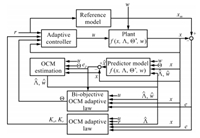
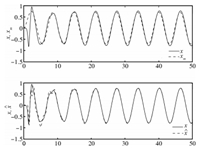

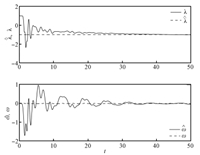
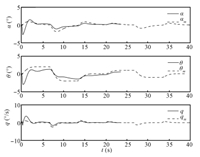
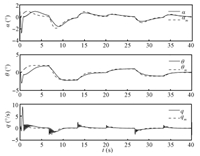
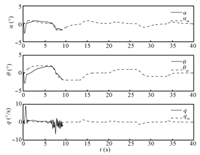
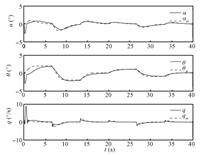
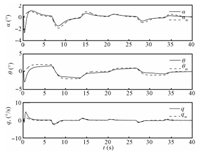

 2014, Vol.1
2014, Vol.1 

